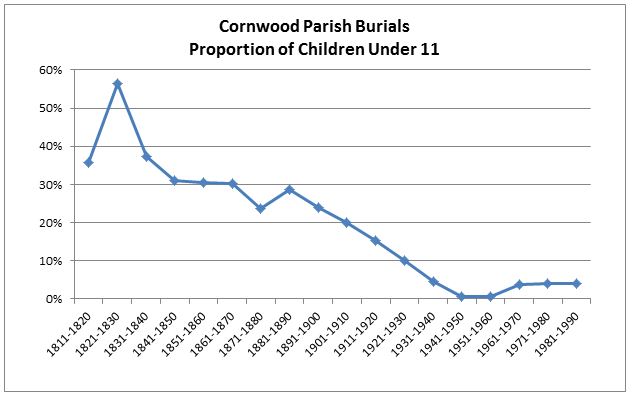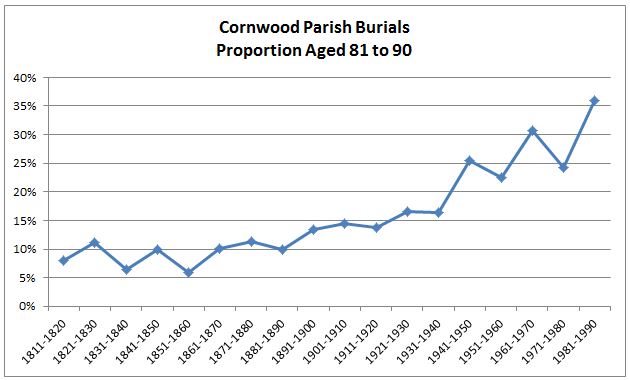In
a previous post I mused on how old, on average, people were when they died in
Cornwood Parish, Devon, in particular those members of my own family. Devon is where
my paternal line came from, or at least lived for over 300 years. Cornwood is a
rural area in southwest Devon – no big towns, no industry. It has always been a
relatively quiet place, with most people occupied on the land. In recent, post
WWII years it has become somewhat of a bedroom community with residents
commuting to Plymouth to work. Notwithstanding all that, the population has not
changed much since the early 1800s.
The
main cemetery is located at St. Michael and All Angels church and here people
of many denominations were buried. Whether the age at death trends are similar
to other areas I don’t know yet. I will probably do a similar summary of adjacent
parishes, some more urban in character, to see.
Figure
1 shows the total burials in the parish since 1811. Ages at death were rarely
recorded prior to them so no trend can be seen. Burials more than doubled during
the first few decades likely as a result of growth in population. Baptisms also
grew over four-fold from the early 1700s before peaking out about 1820. From
around 1850 both baptisms and burials declined, at least as far as the church
records go. That may be partly due to people moving away from the church in
their daily lives. We do know that, as of 1837, birth, marriage and death
records had to be recorded in civil records so parish church registers lost
some of their usefulness except for active parishioners. We also know that the
population of the parish did not diminish into the 20th century. But
that’s another story. What I think we can deduce is that the general statistics
and ratios in the church burial records represent those of the overall
community.
The
two things we might have expected are that death among children would have
declined and the average age at death might have climbed over the last two
hundred years. The graphs do not disappoint in that regard.
What
did surprise me, although I should have realized this before since I have
worked with the parish BMDs for so long, is that over 50% of the deaths in the
decade 1821-1830 were children under the age of eleven, most under five years
old. Even 30% by 1841-1850 seems high but unchecked diseases such as measles,
typhus or tuberculosis, took their toll in those years, especially on the
young. Similar trends exist for older age groups: the ratio for those 11 to 20
dropped from 10% in 1851-1860 to less than 1% in 1981-1990; for those 21 to 30,
it drops from 14% to near zero; for those 31 to 40, from 10% also to less than 1%.
Judging
by the trends shown for other age groups, there is no doubt that people lived
considerably longer in the later decades. By 1981-1990, 35% of burials were of
people who had reached their 80s. Another 5% were 90 or over, an age rarely
seen in the early 19th century. The main working class ages, 41 to
60, stayed about the same across the years but the proportions of people aged
61 to 80 buried in the 1980s more than doubled between 1830 and 1990, as might
be expected.
The
decade of 1911-1920 saw a jump in the number of deaths of people from infant
age to the early twenties. A number of young adults died in 1918, many of them
women, so the spike might partly represent deaths from the Spanish Flu pandemic.
Certainly some of the burials might also have been of servicemen who died during WWI.
Most of the children died in 1911, although not all in a short time period, so that
may rule out an epidemic. The sample is just too small to really know what was
going on but it’s worth looking at further.
One
can read a lot of things into trends of births and deaths. Analyses like this
are worth doing for family historians as it may give them another perspective
of life in the communities in which their ancestors lived. In Cornwood, we can
say that the burial numbers reflect a growing improvement in the health of
residents with small peaks generally representative of epidemics which
occasionally attacked the community. Such events were rare after the discovery
of vaccinations and improvements in water and waste treatment.
It
was in interesting little exercise. Most of my ancestors fit right in with the
averages which is why I wanted to look at the numbers to start with. Next I will
review some nearby parishes that contain more urban settings, to see if similar
trends exist.
Wayne Shepheard is a volunteer with the Online Parish Clerk program in England, handling four
parishes in Devon, England. He has published a
number of articles about various aspects of genealogy and is the Editor of Relatively Speaking, the
quarterly journal of the Alberta Genealogical Society. Wayne also provides
genealogical consulting services through his business, Family History Facilitated.



No comments:
Post a Comment